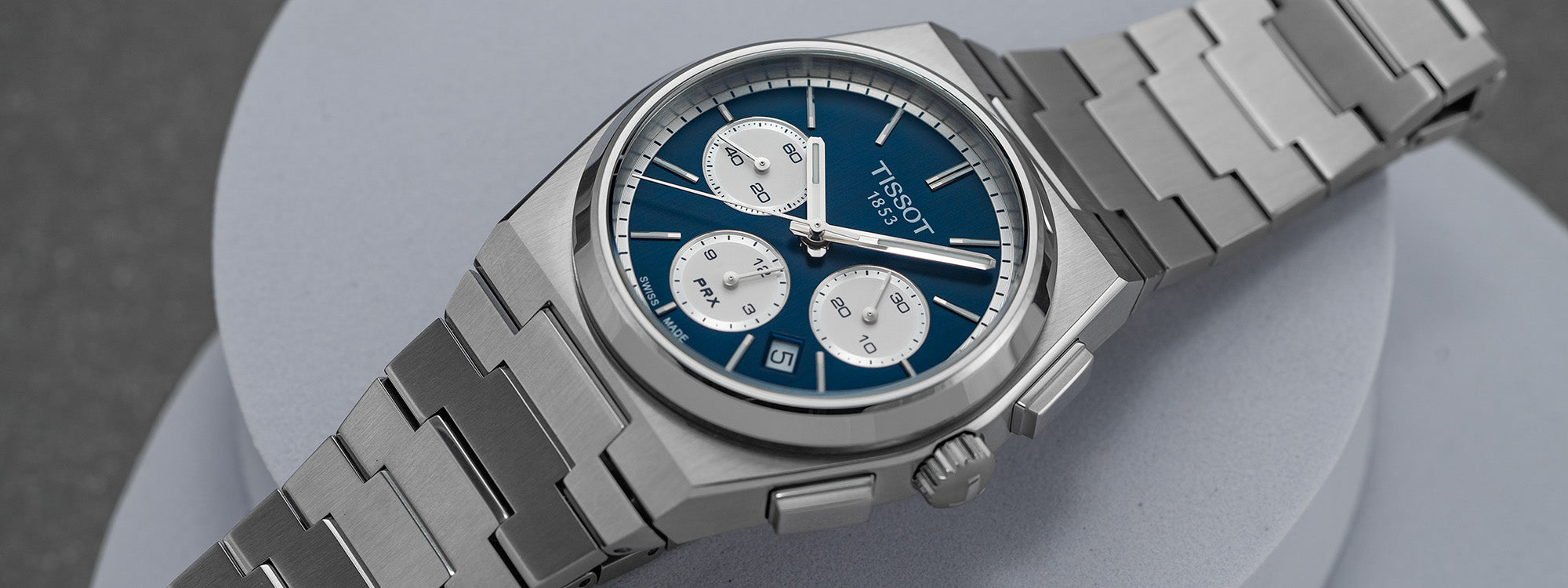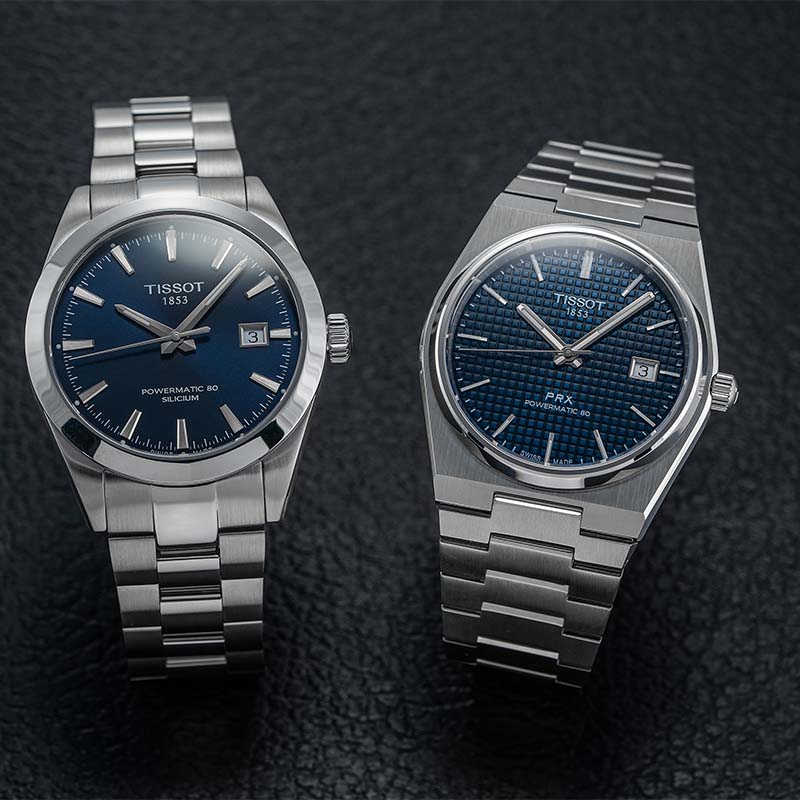The Tissot PRX Chronograph is one of the latest releases from the Tissot PRX collection, one of the Swiss brand’s major success stories of the past decade despite its relatively recent introduction (or, more accurately, re-introduction) to the market. Engaging the 21st-Century watch-aficionado zeitgeist with its crowd-pleasing combination of classical sport-luxury design, intriguing colorways, and accessible price points, the Tissot PRX has grown from a handful of models to become a modern pillar of the 170-year-old brand’s sprawling and diverse portfolio, adding the first chronograph models to the growing lineup in 2022.
Tissot PRX Origins

It all started with the original Tissot PRX watch, which debuted in 1978 and which, like many watches from that era, was powered by a quartz movement. The PRX was distinguished by its flat, barrel-shaped, multi-faceted case, which integrated smoothly into a flexible, articulated steel bracelet; it took its three-initial model name from its attributes: the “P” and “R” stand for “precise” and “robust,”respectively, and the “X” is actually a Roman numeral “10” depicting the model’s 10 atmospheres (aka 100 meters) of water resistance. The overall aesthetic was one that today’s watch historians will readily recognize, hearkening back to the groundbreaking design of a much pricier watch that had debuted several years earlier, in 1972, the Audemars Piguet Royal Oak.
The latter had, in fact, exerted influence on a number of so-called “sport-luxury” timepieces that debuted in the Decade of Disco, from icons like the Patek Philippe Nautilus to cult-classics like the Girard-Perregaux Laureato and Vacheron Constantin 222, the progenitor of the Overseas collection. Tissot’s PRX, as per the value-oriented brand’s strategy, was by far the most affordable alternative to those watches, most of which hailed from brands known for high luxury and high horology and featured mechanical rather than quartz calibers. Despite all this, the Tissot PRX’s shelf-life was relatively short and it was discontinued several years after its launch — presumably, as with other traditional Swiss-made analog watches, pushed out to make room for the Japanese-made digital watches that dominated the early ‘80s. The PRX remained mothballed until 2021, when Tissot CEO Sylvain Dolla discovered it while perusing the archives and seized upon the 1970s cult-classic as a foundation upon which to build Tissot’s 21st-Century identity.

True to their ancestors, the first generation of modern Tissot PRX models were outfitted with quartz movements, though they came in a larger case diameter than the original (40mm) and the dials features sun-brushed finishes in lieu of the earlier models’ Royal-Oak-like waffled texture. Shortly thereafter, Tissot released the first automatic PRX models, with the same case diameter but now housing the brand’s version of the Swatch Group-exclusive Powermatic 80 caliber, which derives its numeral from its uncommonly large 80-hour power reserve. These PRX Powermatic models resurrected the waffle pattern on the dials and took the collection to the next level of enthusiast popularity. Tissot doubled down on that success the following year, introducing a slew of new iterations of both the quartz and Powermatic 80 and introducing the first timepieces in the PRX family with a complication other than a simple date display: the PRX Automatic Chronographs (above), which are the watches we’re taking a closer look at here.
Tissot PRX Chronograph Case

The case of the Tissot PRX Chronograph is bigger than those of the three-hand-date Quartz and Automatic models — 42mm in diameter, a full 2mm thicker than those predecessors, and 14.4mm thick, a substantial boost in wrist presence from the 11mm of the Automatic and the slightly slimmer 10.4mm of the Quartz. This is, of course, to be expected to accommodate the presence of a self-winding chronograph movement, more on which below. Carrying on the tonneau shape of the original PRX and made of 316L stainless steel, the case features a satin-brushed finish on most of its surfaces, interrupted by a few well-placed polished facets.

It’s rated to 100 meters (10 bar) of water resistance, which is about standard for a sporty chronograph at this level, and certainly more than enough for most wearers. There’s probably no reason to ever wear this watch in the water anyway. The round, slightly stepped bezel provides a frame for the sapphire crystal, which is scratch-resistant and treated with antireflective coating. The push-pull crown is fluted for easy gripping and sandwiched between two rather prominent rectangular chronograph push-buttons whose flat top surfaces follow the contours of the case.
Tissot PRX Chronograph Dial
Much of the appeal of the Tissot PRX Chronograph undoubtedly comes from its dial, which manages to be charmingly retro and aggressively modern at the same time. The first round of releases in 2022 included a classical “panda” design, with white dial and contrasting black subdials; and a “reverse panda” option with white subdials on a blue main dial, both of which are pictured in this review. Tissot followed up with the first monochromatic version, with dial and subdials in dark green, and the “Blue Panda” version, which swaps out the black subdials for dark blue ones.

The baton hour and minute hands are bluntly tapered at their tips and sweep along a circle of thin, faceted hour markers along with a center-mounted, lancet-style sweep-seconds hand. On the “panda” model, these hands and markers are gold-plated; on the blue “reverse” model, they’re rhodium-plated. Super-LumiNova coats all these elements, helping them to emit a minty blue glow in low light. Outside the ring of hour markers is a minute track in a color matching that of the subdials. A tilted date window is positioned at 4:30, with black numerals on a white disk. This utilitarian feature disrupts the symmetry of the dial just a bit, albeit less so on the models with white-toned dials. (It particularly stands out like a sore thumb on the green-dialed model, which isn’t pictured here.)

Looking closely at the dials, you’ll notice an array of subtle textured motifs, starting with the vertical satin-brushed finish on the main dial surface, a feature that sets the Chronograph models apart from the three-handed Powermatic 80 versions — though the waffle pattern of the latter is used on the aforementioned green-dial version of the Automatic Chronograph. Presumably, this will be a stylistic difference between bicolor and monochromatic versions of the PRX Automatic Chronographs going forward.

The outer tracks of both the dial and the three subdials, at 3, 6, and 9 o’clock, have a snail-like texture of concentric circles, somewhat evocative of the grooves on an old record album. The subdial at 9 o’clock displays the running seconds while the watch is keeping regular time, while the subdials at 3 and 6 o’clock, along with the central seconds hand, spring into action when the wearer activates the chronograph via the pushers, tallying up to 30 elapsed minutes and 12 elapsed hours, respectively.
Powermatic Movement
The Tissot PRX Chronograph caseback sapphire window affords a view of the movement inside the PRX Automatic Chronograph, the self-winding ETA A05.H31, which is based on the ETA Valjoux 7753, which in turn traces its own lineage to the legendary Valjoux 7750. It’s an impressive chronograph pedigree for a very reasonable sticker price. Among the many descendants of these foundational self-winding chronograph calibers, which can be found throughout the industry, it’s worth noting that the A05 family of movements are exclusive to watchmakers within the Swatch Group. These would include Tissot as well as Longines, Hamilton, Rado, Mido, and Certina; the Swatch Group also owns ETA, which bought Valjoux to consolidate all of this expertise in the first place, but that’s a story for another time.

As for the movement itself, it brings some impressive technical details to bear as well as a level of high-horology finishing that is — like the finishing on exterior elements like the case and bracelet — somewhat rare at this price level. The rotor, borne on ball bearings, winds the mainspring in one direction to amass a lengthy power reserve of 60 hours — not quite the 80 hours of the three-handed PRX Powermatics, but amped up from the 48 hours of the base 7753 movement thanks to an increased barrel - and certainly good enough to get the wearer through a weekend without rewinding. The balance beats at 28,800 vph, ensuring impressive precision for the cam-driven chronograph function. Also built in are a hacking seconds function and a quick-set mechanism for changing the date, along with mainstays like Incabloc shock protection and an Etachron regulator. Behind the cutouts of the partially openworked rotor, you can glimpse the perlage finishing on the bridges and plates.
Tissot PRX Chronograph Bracelet

The satin-brushed finishing of the sharply angled tonneau case continues onto the supple monolink bracelet, which seems to flow organically from the case and tapers sharply and stylishly from the top and bottom lugs of the case down to the fasteners of the butterfly-style folding clasp. The clasp, which snaps into place to secure the watch to the wrist in an understated fashion, is also satin-brushed and is emblazoned with “Tissot” and “1853” on either of its end links. The broad, flat, specially shaped links ripple into each other for a supple fit and catch light reflections at interesting angles as the watch follows the motions of the wrist. Because of the integrated-style design, those who wish to swap this bracelet out for a strap aren’t going to have many options; Tissot makes some PRX Powermatic 80 models that are mounted on leather straps, but has yet to introduce this option into the collection’s Chronographs.

Pricing and Value:
At an MSRP of just under $2,000 before taxes — $1,995, to be exact — a watch enthusiast would be hard-pressed to find a better value proposition in the always-competitive field of mechanical chronographs that are comfortable and tough enough to wear every day while still being stylish enough to show off on special occasions. Swiss-made automatic movement with impressive pedigree? Check. Elite levels of build and finishing for the price? Check. Retro charm contrasting with, yet somehow enhancing, avant-garde colorways and dial treatments? Check and check. The only factor that might give prospective buyers pause are the size, particularly the thickness, and the PRX design itself, which, while widely popular, isn’t for everyone. For those folks, we’ve compiled the addendum below, right after the specs box.
The PRX Isn't for you? Here are Some Other Tissot Chronographs:
Tissot Seastar 1000 Chronograph ($575)

Tissot’s Seastar line is made up of the brand’s purpose-built dive watches, dating back to the 1960s and encompasses a variety of sizes, colorways, and levels of water resistance. The Chronograph version of the Tissot Seastar 1000 (the numeral refers to its 1,000-meter depth rating) carries an ETA-built quartz caliber inside its substantial 45.5mm stainless steel case. The movement, behind a solid screw-down caseback, allows for 1/10-second chronograph measurements and “ADD/SPLIT” functionality. The unidirectional rotating dive-scale bezel, with an aluminum ring, surrounds a three-register dial that is offered in an array of brightly colored gradient iterations and hosts a set of highly luminous hands and indexes. If you’re in the market for a robust, affordable chronograph that you can actually wear on a diving expedition — and you don’t mind that it’s got a quartz movement — this one might be your ideal choice.
Tissot Heritage 1973 ($2,395)

Released in 2019, the Heritage 1973 is a motorsport-inspired chronograph whose retro design hearkens back to the Tissot Navigator, a watch worn in the 1970s by Swiss Formula One driver Loris Kessel. Tissot worked with Kessel’s son and his racing team to produce this modern homage, with an expanded, cushion-shaped 43mm steel case with an array of high-end finishes and a sharp, black-and-white “panda”-style dial bordered by a black tachymeter scale on its periphery. The front crystal is scratch-resistant sapphire, while the back exhibition window uses a more period-appropriate mineral glass to showcase the automatic, integrated-chronograph caliber inside, with its golden rotor engraved with a Tissot logo. The black calfskin strap with racing-style perforations is a reproduction of the original.
Tissot Telemeter 1938 ($2,225)

Hitting the market in Fall 2022, the Telemeter 1938 channels the retro charm of its namesake year with its two-register chronograph dial, with subdials framed by railroad track scales and concentrically oriented, spiraling scales: a telemeter scale that can be used in conjunction with the built-in stopwatch to measure the wearer’s distance from a visible, audible event like a lightning strike, and a tachymeter scale to measure speeds over a set distance. Also evoking the 1938 original, which Tissot built to time ski races, are the sword-shaped hands and period-appropriate Arabic numerals. The new automatic movement inside, the ETA Valjoux A05.231, stores 68 hours of power and includes an antimagnetic Nivachron hairspring to increase precision.
Tissot PRS516 Mechanical ($1,850)

This flagship of Tissot’s recently revived, motorsport-inspired PRS516 family traces its most direct inspiration to the Ref. 40528 from the 1970s and features a manually winding mechanical movement, the ETA Valjoux A05.291, which like the PRX caliber is based on the Valjoux 7753. The base caliber’s winding rotor has been removed and replaced with a new bridge inscribed with “TISSOT 1853,” while the mainspring of the retooled movement has a fixed bridle instead of its original sliding one, a failsafe measure to make sure the mainspring locks when it’s fully wound; its power reserve is even bigger than its automatic cousin’s, at 68 hours. The spirit of the watch’s 1970s ancestor also lives on in its exterior aesthetics, particularly the dual-scale bicolor bezel, which like the original watch features both a tachymeter scale and a pulsation scale — the former for calculating speed, the latter for checking heart rates, both useful in a competitive racing environment. The 41mm, barrel-shaped steel case protects the tricompax dial, with its blue and orange details, under a retro-style box crystal. You can learn more at tissotwatches.com.


























































0 Comments